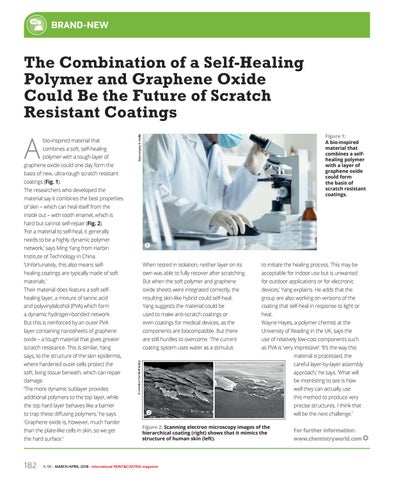BRAND-NEW
The Combination of a Self-Healing Polymer and Graphene Oxide Could Be the Future of Scratch Resistant Coatings combines a soft, self-healing polymer with a tough layer of
graphene oxide could one day form the
Figure 1: A bio-inspired material that combines a selfhealing polymer with a layer of graphene oxide could form the basis of scratch resistant coatings.
18percentgrey © Fotolia
A
bio-inspired material that
basis of new, ultra-tough scratch resistant coatings (Fig. 1). The researchers who developed the material say it combines the best properties of skin – which can heal itself from the inside out – with tooth enamel, which is hard but cannot self-repair (Fig. 2). ‘For a material to self-heal, it generally needs to be a highly dynamic polymer
1
network,’ says Ming Yang from Harbin Institute of Technology in China. ‘Unfortunately, this also means self-
When tested in isolation, neither layer on its
to initiate the healing process. This may be
healing coatings are typically made of soft
own was able to fully recover after scratching.
acceptable for indoor use but is unwanted
materials.’
But when the soft polymer and graphene
for outdoor applications or for electronic
Their material does feature a soft self-
oxide sheets were integrated correctly, the
devices,’ Yang explains. He adds that the
healing layer, a mixture of tannic acid
resulting skin-like hybrid could self-heal.
group are also working on versions of the
and polyvinylalcohol (PVA) which form
Yang suggests the material could be
coating that self-heal in response to light or
a dynamic hydrogen-bonded network.
used to make anti-scratch coatings or
heat.
But this is reinforced by an outer PVA
even coatings for medical devices, as the
Wayne Hayes, a polymer chemist at the
layer containing nanosheets of graphene
components are biocompatible. But there
University of Reading in the UK, says the
oxide – a tough material that gives greater
are still hurdles to overcome. ‘The current
use of relatively low-cost components such
scratch resistance. This is similar, Yang
coating system uses water as a stimulus
as PVA is ‘very impressive’. ‘It’s the way this material is processed, the
where hardened outer cells protect the
careful layer-by-layer assembly
soft, living tissue beneath, which can repair damage. ‘The more dynamic sublayer provides additional polymers to the top layer, while
© American Chemical Society
says, to the structure of the skin epidermis,
approach,’ he says. ‘What will be interesting to see is how well they can actually use this method to produce very precise structures. I think that
the top hard layer behaves like a barrier to trap these diffusing polymers,’ he says. ‘Graphene oxide is, however, much harder than the plate-like cells in skin, so we get the hard surface.’
182
2 1
Figure 2: Scanning electron microscopy images of the hierarchical coating (right) shows that it mimics the structure of human skin (left).
N. 50 - MARCH/APRIL 2018 - international PAINT&COATING magazine
will be the next challenge.’ For further information: www.chemistryworld.com
